
Jet A1 Fuel Viscosity: Key Properties Explained
At GLOBAL TERMINAL NETHERLANDS B.V, we understand the critical role Jet A1 fuel plays in aviation. One of its key properties, viscosity, significantly impacts aircraft performance and safety.
In this post, we’ll explore Jet A1 fuel viscosity, its importance, and how it affects various aspects of flight operations. We’ll also discuss the factors influencing viscosity and its implications for fuel handling and storage.
What Makes Jet A1 Fuel Unique?
Complex Hydrocarbon Blend
Jet A1 fuel powers modern aviation as a sophisticated mixture of hydrocarbons. It primarily consists of normal and iso-paraffins, cycloparaffins, and aromatics. This carefully balanced composition ensures optimal performance across various flight conditions. The specific blend can vary slightly depending on the crude oil source and refining process, but it must always meet stringent international standards.
Critical Performance Characteristics
Several key characteristics define Jet A1 fuel:
- Flash Point: Jet A1 has a minimum flash point of 38°C (100°F), which enhances safety during handling and storage.
- Freezing Point: With a maximum freezing point of -47°C (-52.6°F), Jet A1 remains fluid at high altitudes.
- Energy Content: Jet A1 delivers approximately 43.15 MJ/kg, providing excellent energy density for long-range flights.
- Thermal Stability: This fuel resists breakdown at high temperatures, which is essential for modern high-performance jet engines.
Viscosity: A Key Property
Viscosity plays a pivotal role in Jet A1 fuel performance. It affects everything from fuel flow through pipes and filters to atomization in combustion chambers. Jet-A is a high-purity kerosene based fuel manufactured under a specific ASTM standard (D1655), with specific physical properties, and is used in jet turbine engines.
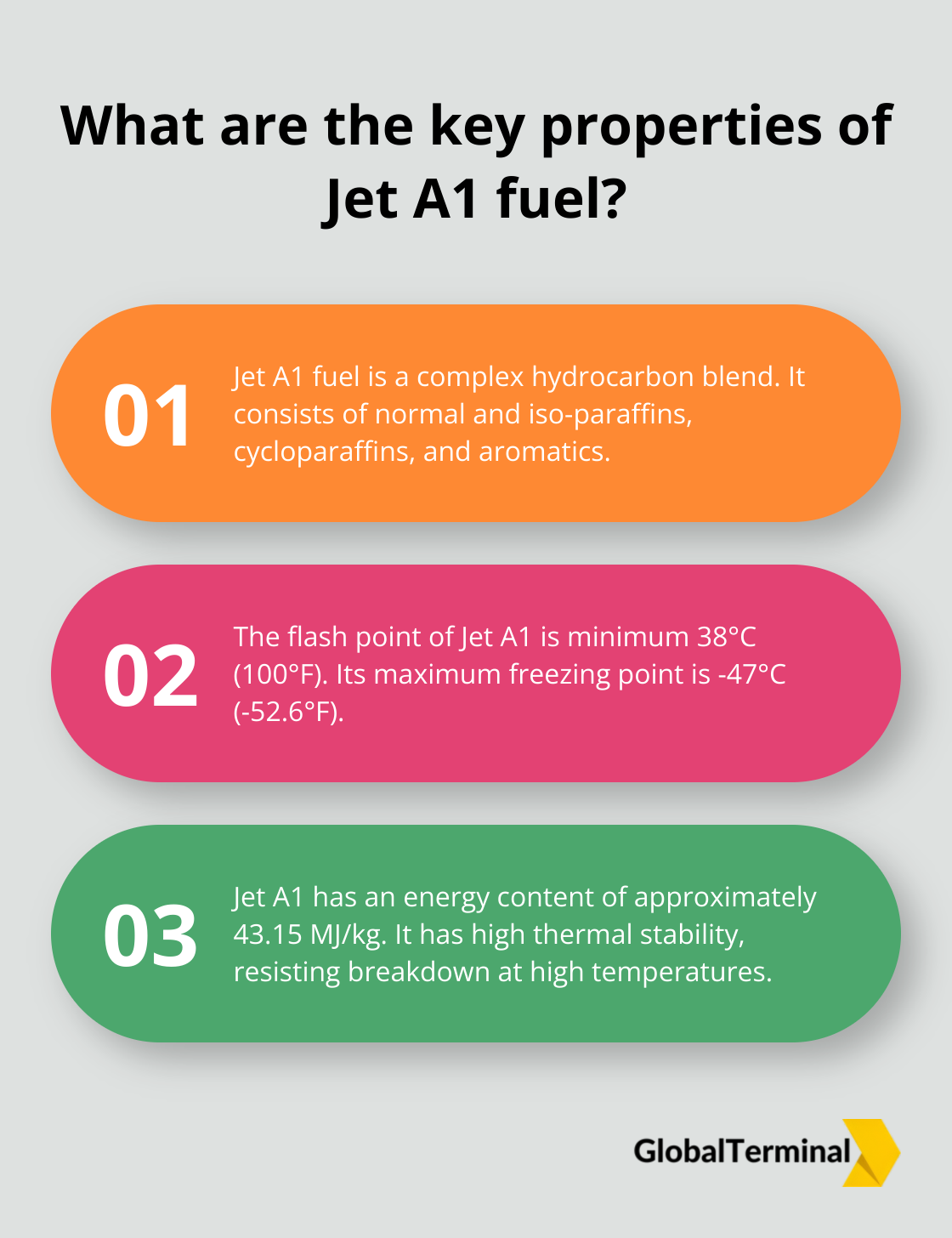
Viscosity directly impacts an aircraft’s operational efficiency. Low-temperature viscosity determines how well the fuel will flow in cold conditions at high altitudes. This property is so important that airlines and fuel suppliers constantly monitor and adjust for it, especially in colder climates.
Impact on Aircraft Operations
The unique properties of Jet A1 fuel significantly influence aircraft operations:
- Engine Performance: The fuel’s composition and energy content directly affect engine thrust and efficiency.
- Range and Payload: The high energy density allows aircraft to fly longer distances or carry heavier loads.
- Cold Weather Operations: The low freezing point and controlled viscosity enable reliable performance in extreme cold conditions.
Future Developments
As aviation technology advances, fuel properties will continue to evolve. Researchers and engineers work on developing sustainable alternatives that maintain or improve upon the performance characteristics of traditional Jet A1 fuel. These efforts focus on reducing environmental impact while maintaining the high standards of safety and efficiency that modern aviation demands.
The next chapter will explore the specific aspects of Jet A1 fuel viscosity in greater detail, including its definition, typical ranges, and the factors that influence this critical property.
What Determines Jet A1 Fuel Viscosity?
Definition of Fuel Viscosity
Jet A1 fuel viscosity refers to its resistance to flow. This property measures the fuel’s thickness or fluidity, which affects its movement through pipes, filters, and fuel systems, as well as its atomization in the engine’s combustion chamber. The aviation industry typically measures Jet A1 fuel viscosity in centistokes (cSt) at -20°C, as specified by ASTM D1655.
Viscosity Range for Jet A1 Fuel
ASTM D1655 sets the maximum allowable viscosity for Jet A1 fuel at 8.0 cSt at -20°C. This specification ensures adequate fuel flow even in cold conditions at high altitudes. Low viscosity can lead to excessive leakage past the injection pump plunger, resulting in inaccurate fuel metering and reduced engine efficiency.
Temperature Effects on Viscosity
Temperature plays a significant role in Jet A1 fuel viscosity. As temperatures drop, viscosity increases, making the fuel thicker and more resistant to flow. This relationship becomes particularly important for aviation, where aircraft operate at high altitudes with extremely low temperatures. Jet A typically shows a steeper increase of viscosity with decreasing temperatures compared to other aviation fuels.
Composition and Refining Process
The chemical makeup of Jet A1 fuel directly influences its viscosity. The fuel’s composition, determined by the crude oil source and refining process, affects its flow characteristics. Heavier hydrocarbon components tend to increase viscosity, while lighter components decrease it. Refineries carefully control the distillation process to achieve the desired viscosity range.
Additives and Their Impact
Certain additives can impact the fuel’s viscosity characteristics, especially at lower temperatures. Pour point depressants, for example, can help maintain fuel fluidity in extremely cold conditions. These additives (often proprietary blends) modify the fuel’s behavior without significantly altering its overall composition or performance characteristics.
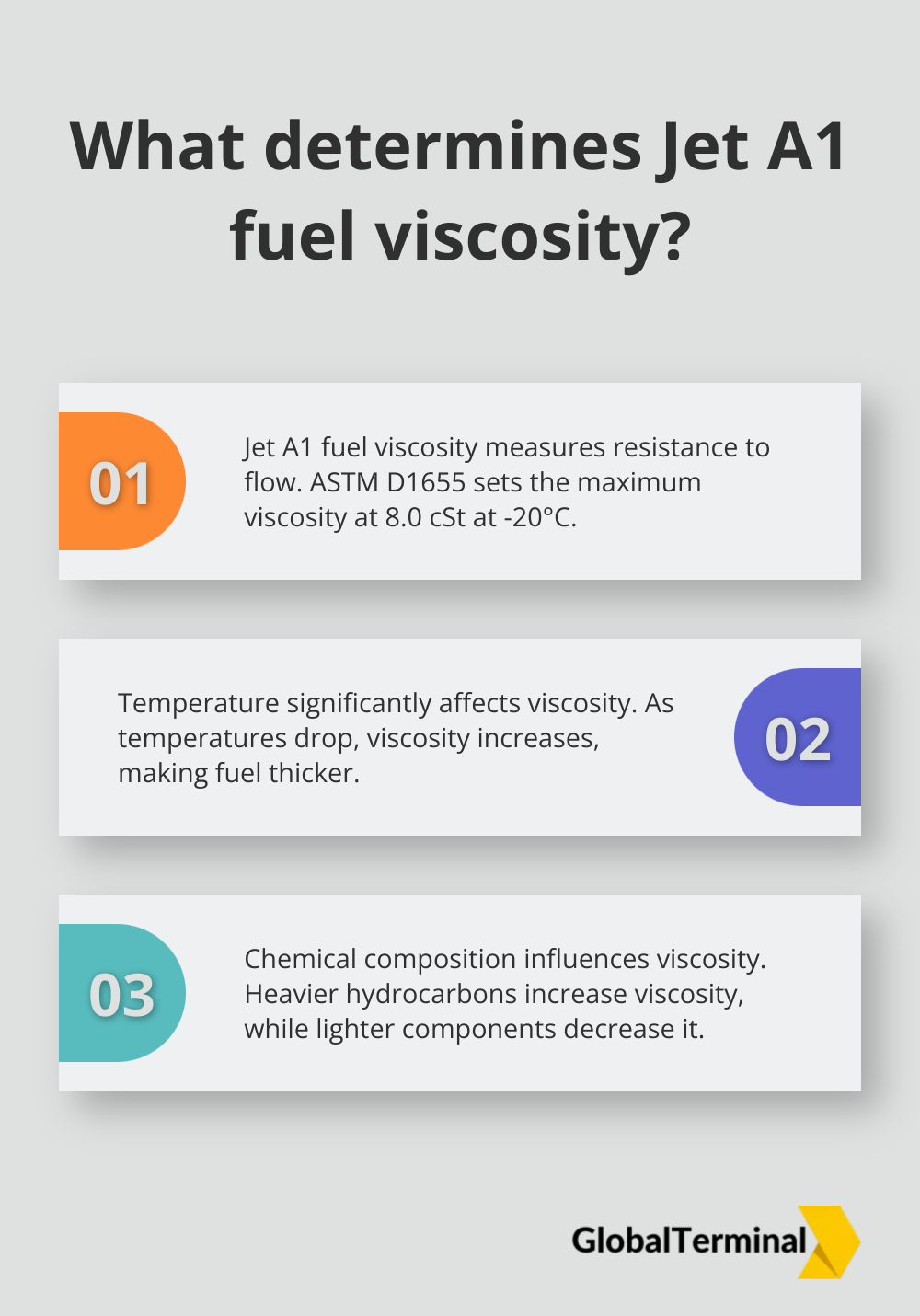
The complex interplay of these factors determines the final viscosity of Jet A1 fuel. Understanding these determinants allows for better fuel management and system design, ensuring optimal performance across a wide range of operating conditions. In the next chapter, we’ll explore how viscosity impacts various aspects of aircraft performance and why it’s a key consideration in fuel system design and cold weather operations.
How Jet A1 Viscosity Affects Aircraft Performance
Fuel Flow and Atomization
Jet A1 fuel viscosity significantly impacts aircraft performance, influencing fuel flow and atomization. Higher viscosity can reduce fuel flow rates, potentially causing fuel starvation in extreme cases.
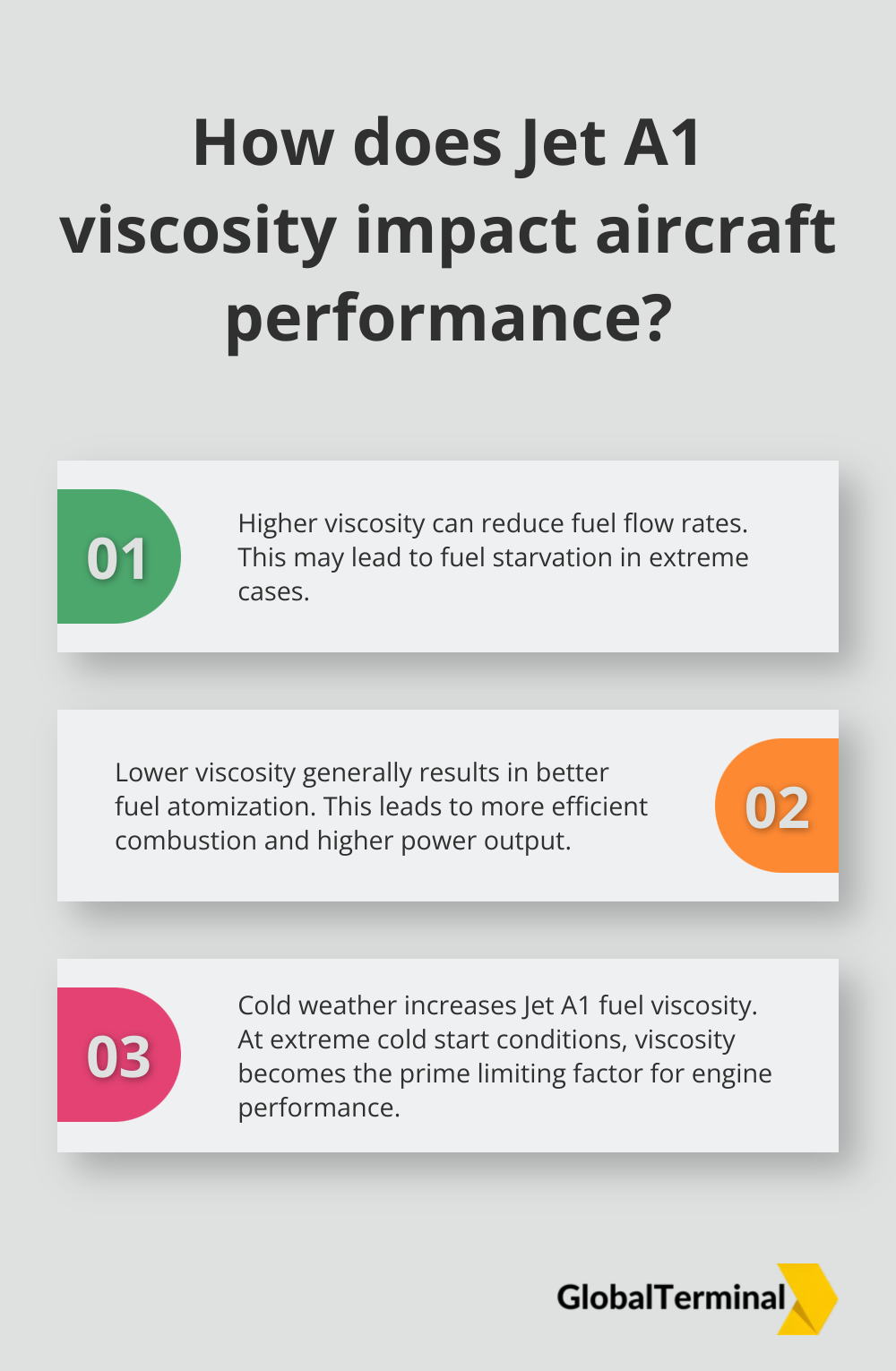
Viscosity also affects atomization, the process of breaking fuel into fine droplets for combustion. Higher viscosity fuels form larger droplets, which can lead to incomplete combustion and reduced engine efficiency.
Engine Efficiency and Power Output
Fuel viscosity plays a key role in engine performance. Lower viscosity generally leads to better fuel atomization, resulting in more efficient combustion and higher power output.
However, excessively low viscosity can cause issues with fuel pump lubrication and increase the risk of fuel system leaks. Finding the right balance is essential for optimal engine performance.
Cold Weather Operations
In cold weather conditions, Jet A1 fuel viscosity becomes even more important. As temperatures drop, viscosity increases, potentially leading to fuel flow issues. At extreme cold start conditions, viscosity becomes the prime limiting factor for engine performance.
To mitigate these risks, airlines often use fuel heaters or additives to maintain proper viscosity in cold conditions. Some aircraft manufacturers recommend specific operational procedures for cold weather, such as running engines at idle for longer periods before takeoff to ensure proper fuel flow.
Fuel System Design Considerations
Aircraft fuel system designers must account for viscosity variations to ensure reliable performance across a wide range of operating conditions. This includes:
- Selecting appropriate pump sizes and types
- Designing fuel lines with proper diameters and configurations
- Incorporating fuel heaters or cooling systems as needed
- Specifying filtration systems that can handle varying fuel viscosities
These design considerations help maintain optimal fuel flow and atomization, even when viscosity fluctuates due to temperature changes or other factors.
Final Thoughts
Jet A1 fuel viscosity impacts every aspect of aircraft operation, from engine efficiency to cold weather reliability. This property influences fuel flow, atomization, and overall engine output, making it a key consideration for the aviation industry. The implications of Jet A1 fuel viscosity extend beyond aircraft performance to fuel handling and storage practices.
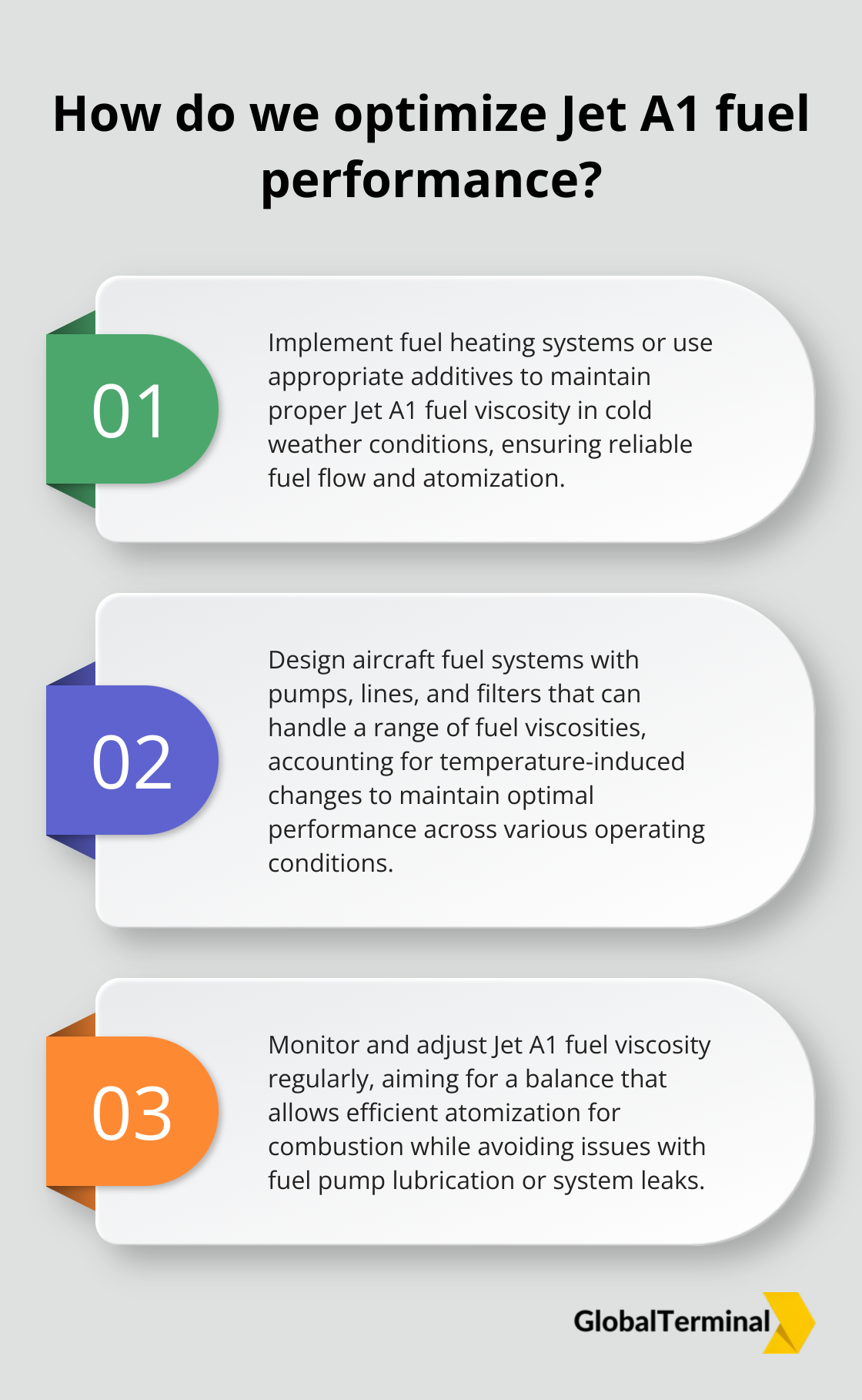
The aviation industry faces new challenges in fuel development, particularly in creating sustainable alternatives that maintain optimal viscosity characteristics. Researchers work to develop options that offer the same reliability and performance while reducing environmental impact. These efforts will shape the future of aviation fuel technology and operational procedures.
At GLOBAL TERMINAL NETHERLANDS B.V, we understand the importance of Jet A1 fuel viscosity in aviation. Our storage facilities and logistics solutions are designed to maintain fuel integrity (ensuring it meets viscosity requirements for safe flight operations). We support the aviation industry’s need for reliable, high-quality fuel supply through our services.

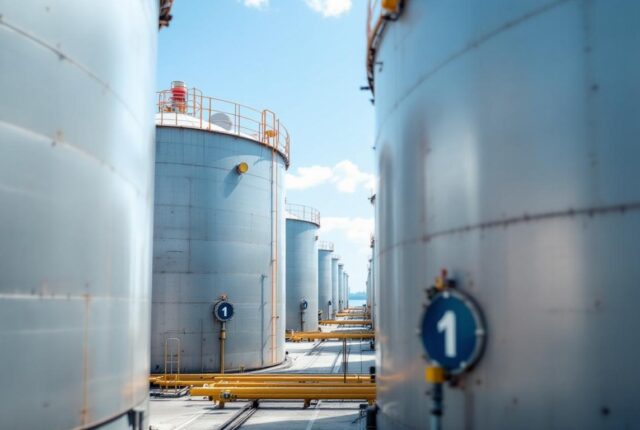
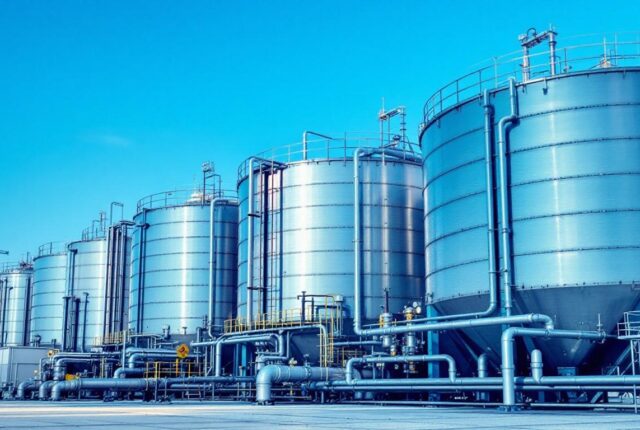
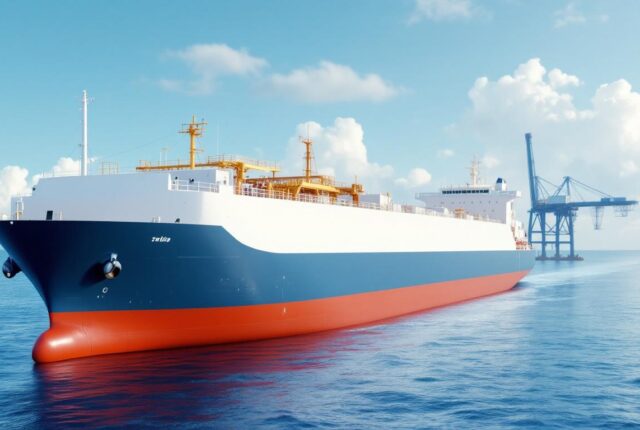

Leave a Reply